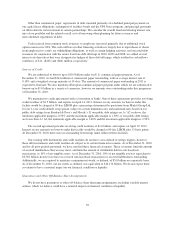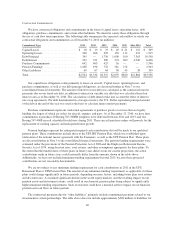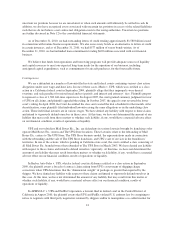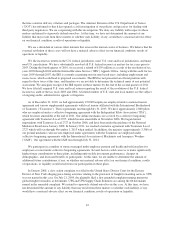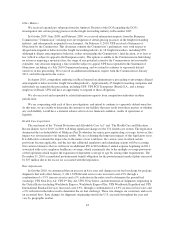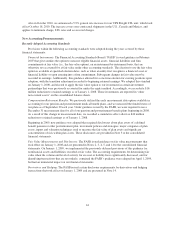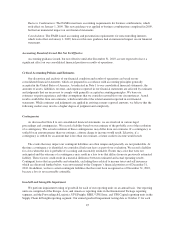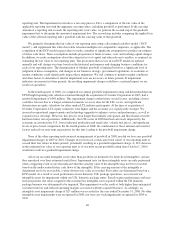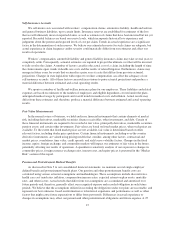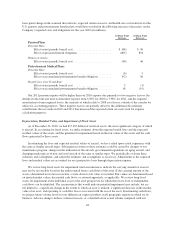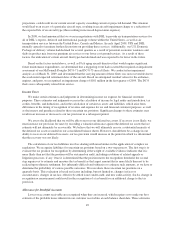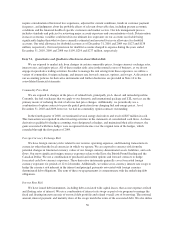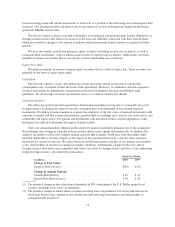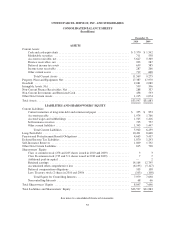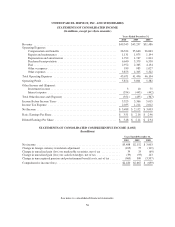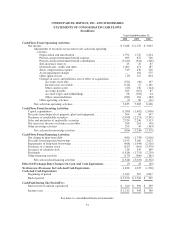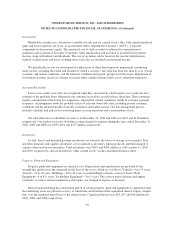UPS 2010 Annual Report Download - page 61
Download and view the complete annual report
Please find page 61 of the 2010 UPS annual report below. You can navigate through the pages in the report by either clicking on the pages listed below, or by using the keyword search tool below to find specific information within the annual report.projections, could result in our current aircraft capacity exceeding current or projected demand. This situation
would lead to an excess of a particular aircraft type, resulting in an aircraft impairment charge or a reduction of
the expected life of an aircraft type (thus resulting in increased depreciation expense).
In 2008, we had announced that we were in negotiations with DHL to provide air transportation services for
all of DHL’s express, deferred and international package volume within the United States, as well as air
transportation services between the United States, Canada and Mexico. In early April 2009, UPS and DHL
mutually agreed to terminate further discussions on providing these services. Additionally, our U.S. Domestic
Package air delivery volume had declined for several quarters as a result of persistent economic weakness and
shifts in product mix from our premium air services to our lower cost ground services. As a result of these
factors, the utilization of certain aircraft fleet types had declined and was expected to be lower in the future.
Based on the factors noted above, as well as FAA aging aircraft directives that would require significant
future maintenance expenditures, we determined that a triggering event had occurred that required an impairment
assessment of our McDonnell-Douglas DC-8-71 and DC-8-73 aircraft fleets. We conducted an impairment
analysis as of March 31, 2009, and determined that the carrying amount of these fleets was not recoverable due to
the accelerated expected retirement dates of the aircraft. Based on anticipated residual values for the airframes,
engines, and parts, we recognized an impairment charge of $181 million in the first quarter of 2009. The DC-8
fleets were subsequently retired from service.
Income Taxes
We make certain estimates and judgments in determining income tax expense for financial statement
purposes. These estimates and judgments occur in the calculation of income by legal entity and jurisdiction, tax
credits, benefits, and deductions, and in the calculation of certain tax assets and liabilities, which arise from
differences in the timing of recognition of revenue and expense for tax and financial statement purposes, as well
as the interest and penalties related to these uncertain tax positions. Significant changes to these estimates may
result in an increase or decrease to our tax provision in a subsequent period.
We assess the likelihood that we will be able to recover our deferred tax assets. If recovery is not likely, we
must increase our provision for taxes by recording a valuation allowance against the deferred tax assets that we
estimate will not ultimately be recoverable. We believe that we will ultimately recover a substantial majority of
the deferred tax assets recorded on our consolidated balance sheets. However, should there be a change in our
ability to recover our deferred tax assets, our tax provision would increase in the period in which we determined
that the recovery was not likely.
The calculation of our tax liabilities involves dealing with uncertainties in the application of complex tax
regulations. We recognize liabilities for uncertain tax positions based on a two-step process. The first step is to
evaluate the tax position for recognition by determining if the weight of available evidence indicates that it is
more likely than not that the position will be sustained on audit, including resolution of related appeals or
litigation processes, if any. Once it is determined that the position meets the recognition threshold, the second
step requires us to estimate and measure the tax benefit as the largest amount that is more likely than not to be
realized upon ultimate settlement. It is inherently difficult and subjective to estimate such amounts, as we have to
determine the probability of various possible outcomes. We reevaluate these uncertain tax positions on a
quarterly basis. This evaluation is based on factors including, but not limited to, changes in facts or
circumstances, changes in tax law, effectively settled issues under audit, and new audit activity. Such a change in
recognition or measurement could result in the recognition of a tax benefit or an additional charge to the tax
provision.
Allowance for Doubtful Accounts
Losses on accounts receivable are recognized when they are incurred, which requires us to make our best
estimate of the probable losses inherent in our customer receivables at each balance sheet date. These estimates
49


